
Greutăți și măsuri
| Lungime | de la 35 la 45 mm |
|---|
Descrierea animalului
The Eastern pine processionary (Thaumetopoea pinivora) is a fascinating species of moth that has garnered attention from both the scientific community and the public due to its unique behavior and lifecycle, as well as its impact on pine forests across its native and introduced ranges. This lepidopteran belongs to the family Notodontidae and is closely related to other processionary moth species, which share some of its distinctive habits and characteristics.One of the most striking features of Thaumetopoea pinivora is its larval stage, during which the caterpillars exhibit a remarkable behavior known as "processionary movement." After hatching from eggs laid in neat rows on pine needles, the caterpillars feed collectively on the needles, causing significant defoliation that can weaken or even kill young trees. As they move from one feeding site to another, the caterpillars form long, head-to-tail processions, which can appear quite striking as they traverse the forest floor or tree branches. This behavior is thought to provide several benefits, including protection from predators and thermal regulation.
The caterpillars of the Eastern pine processionary are covered in fine, urticating hairs, which can cause severe allergic reactions in humans and animals. These hairs contain a protein that, upon contact with skin or inhalation, can lead to itching, rashes, and, in more severe cases, respiratory distress. This defense mechanism makes the caterpillars less appealing to potential predators but also poses a risk to forest workers, residents, and pets in affected areas.
The adult moth of Thaumetopoea pinivora is less conspicuous than its larval form. It has a wingspan of approximately 30-40 mm, with males and females exhibiting sexual dimorphism. Males tend to have more distinct markings and a broader wingspan than females. The adults are nocturnal and are not known to feed; their primary purpose is reproduction. After mating, females lay their eggs on the needles of suitable host trees, and the cycle begins anew.
The habitat of the Eastern pine processionary primarily includes pine forests, where it prefers certain species of pine as hosts for its larvae. The moth has a range that spans parts of Europe and Asia, with its distribution being closely tied to that of its preferred pine species. Climate change and global trade have facilitated its spread to new areas, where it can become an invasive pest, threatening local ecosystems and forestry industries.
Efforts to manage and control the populations of Thaumetopoea pinivora involve a combination of methods, including biological control using natural predators or pathogens, mechanical removal of nests, and the use of pheromone traps to capture adult males. Public awareness campaigns also play a crucial role in educating people about the risks associated with the caterpillars and how to avoid them.
In conclusion, the Eastern pine processionary is a species of significant ecological and economic interest. Its unique behaviors, impact on forest health, and interactions with humans and animals make it a subject of ongoing research and management efforts. Understanding and mitigating the challenges posed by Thaumetopoea pinivora require a multidisciplinary approach, integrating entomology, forestry, public health, and community engagement.
Fotografii noi cu animale
Top 10 animale
- Dolphin gull (Leucophaeus scoresbii)
- Diana monkey (Cercopithecus diana)
- Moustached guenon (Cercopithecus cephus)
- Stone loach (Barbatula barbatula)
- Greek tortoise (Testudo graeca)
- Galápagos tortoise (Geochelone nigra complex)
- Japanese macaque (Macaca fuscata)
- Russian tortoise (Testudo horsfieldii)
- Common flying dragon (Draco volans)
- Galápagos penguin (Spheniscus mendiculus)